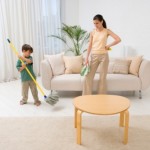Allergy-Proof Your Home
 It’s springtime, if your allergies act up when you’re outside, you might tend to stay indoors. No one wants to be allergic to their home, but that could be what’s happening. If you find yourself sneezing, congested or experiencing other symptoms while sitting in your own home you may want to consider these tips for your weekly cleaning, (especially for major seasonal cleaning) to keep your home fresh.
It’s springtime, if your allergies act up when you’re outside, you might tend to stay indoors. No one wants to be allergic to their home, but that could be what’s happening. If you find yourself sneezing, congested or experiencing other symptoms while sitting in your own home you may want to consider these tips for your weekly cleaning, (especially for major seasonal cleaning) to keep your home fresh.
Shut out pollen
When you clean your windows, do you see a film of pollen on the frame or sill? One easy way to prevent pollen from entering your home is to keep windows and doors closed. Use an air filter and clean it regularly or run the air conditioner and change the filter often. Try to keep your home’s temperature around 70 degrees. Overly warm houses tend to attract dust mites and mold. Keep windows closed, especially during peak allergy seasons of spring and fall, and before you go to sleep. The highest pollen counts are from 4 a.m. to 10 a.m. You’ll wake up feeling symptoms after having a window open all night.
Wash bedding
Wash all bedding every 1–2 weeks and use covers that prevent dust mites on pillows and mattresses. Buy allergen-proof zippered, sealed covers for pillows, mattress, and box springs. Washing bedding in hot water also kills the little insects. The water needs to be at least 130 degrees to work, so check your water heater temperature dial to make sure it’s set that high.
Dust to control mites
By dusting surfaces and washing surfaces often, you can control the amount of dust mites in your home. Wipe window shades and/or wash the curtains. Wash stuffed animals in 130 degrees F water. If they can’t take the stress of washing, put them in a plastic bag in the freezer for a few days.
Vacuum often
Although cleaning can sometimes trigger allergic reactions, with dust in the air, vacuuming once or twice a week will reduce the surface dust mites. Wear a mask when doing housework and consider leaving for a few hours after you clean to avoid allergens in the air. A vacuum that has a special double-lined bag, a HEPA (high-efficiency particulate air) filter, or a combination of both will trap more of the carpet allergens. If you have carpeting, you might want to consider installing hardwood or linoleum flooring, which is easier to keep clean with just a damp mop.
Reduce pet dander
If you have allergies, you should avoid pets with feathers or fur like birds, dogs and cats. Animal saliva and dead skin, or pet dander, can cause allergic reactions. If you can’t bear to part with your pet, you should at least keep it out of the bedroom. Wash your indoor pets, especially cats, after discussing this with your vet.
Avoid mold spores
Mold spores grow in moist areas. If you reduce the moisture in the bathroom and kitchen, you will reduce the mold. Fix any leaks inside and outside of your home and clean moldy surfaces. Plants can carry pollen and mold too, so limit the number of houseplants. Dehumidifiers will also help reduce mold. First, dry up the moisture; seal any cracks, leaks, or drips. Keep the humidity in your home below 50 percent (To track the humidity level, buy a gauge (called a hygrometer) with a digital readout. To clean mold from surfaces, use a mixture of 5 parts bleach to 95 parts water. If the mold covers less than 10 square feet, you can deal with cleanup yourself. Anything over that, you’ll need professionals to remove the contamination.



















